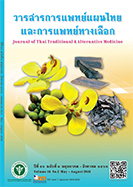The situation of Thai traditional medicine in public health services, Suphanburi province.
Main Article Content
Abstract
The purpose of this study was to explore the situation of Thai traditional medicine (TTM) services at government health-care facilities in Suphan Buri province. Quantitative data were collected from 184 TTM providers (one at each of all 184 health facilities), using a questionnaire for data on TTM administrative structure and personnel, integrated TTM services (massage, herbal steam bath, herbal compression, postpartum rejuvenation and herbal remedies), whereas qualitative data were collected using a focus group discussion with five directors of regional and community hospitals in the province. The data were analyzed using descriptive statistics and content analysis, and also validated using the triangular method. Results showed that all the state health-care facilities provided TTM services according to the provincial TTM service promotion and support policy. Regarding the service system readiness, all 10 regional/general/community hospitals in the province had already set up TTM Units, 4 of which reporting directly to the hospital directors. As for TTM personnel, there were 42 licensed TTM and applied TTM practitioners (including 28 applied TTM practitioners). At each hospital, the proportion of applied TTM practitioners was higher and the number of TTM personnel was less than the established staffing pattern. Most community hospitals provide all kinds of TTM services. For all such hospitals, there were 2,000 outpatient-visits on average per month and inpatient care was available at two hospitals (Somdejprasangkharach XVII and U-Thong). On average, they used 19 single herbal drugs and 20 herbal formulas. The top five commonly used herbal remedies also included turmeric and kariyat in line with the policy on using herbal remedies as first-line drugs. Concerning service integration, two approaches have been found: (1) the TTM or applied TTM practitioner working together with a modern medical doctor at the same outpatient department with patient-screening performed by a nurse and (2) providing treatment collaboratively but from different workplaces with the TTM or applied TTM practitioner undertaking patient-screening and providing treatment.
Article Details
References
[cited 2017 Sep 2]; Available from http://www.hisro.or.th/main/?name=knowledge&fle=readknowledge&id=14. (inThai)
2. Rattanaviliwan S. Evaluation of Thai traditional medicine management in public health facilities under the
universal health coverage scheme. Journal of Thai Traditional & Alternative Medicine. 2007;5(2):131-41.
(in Thai)
3. Bureau of Policy and Strategy. Thailand health profile (2001-2003). Nonthaburi: The Express Transportation
Organization of Thailand; 2003 392 p. (in Thai)
4. Subcharoen P. History of evolution and application of traditional medicine. Bangkok: Samcharoen Panich Co.,
Ltd; 2007. 204 p. (in Thai)
5. Petrakard P, Limpananont J. The situation of Thai traditional medicine utilization in rural public health
facilities and private health facilities. Journal of Health Science. 2007;16(6):859-74. (in Thai)
6. Chantraket R, Limpananont J, Suksut P. The integration of Thai traditional medicine into public health systems:
the role of Buddhist monasteries as health-care providers for communities. Journal of Thai Traditional & Alternative Medicine. 2007;7(2-3):169-80. (in Thai)
7. Chantraket R, Stienrut P, Laohapan T, Sornrung W, Jansorn S. Thai public health system and workforce
planning for Thai traditional medicine in the year 2026. Journal of Health Systems Research. 2018;12(2):254-66.
(in Thai)
8. Puma S, Aungsusing K. Situation of Thai traditional medicine services at Tambon health promoting
hospitals. Journal of Thai Traditional & Alternative Medicine. 2016;14(1):21-36. (in Thai)
9. Information and Communication Technology Centre Office of the Permanent Secretary, Ministry of Public
Health. Accessibility to Thai traditional medicine services according to the Health Data Center (HDC).
[Internet]. 2017 [cited 2017 Sep 10]; Available from: https://hdcservice.moph.go.th/hdc/reports/page.php?
cat_id=30bc6364fc06a33a7802e16bc596ac3b (in Thai)
10. Inspection Bureau, Ministry of Public Health. Inspection plan of the Ministry of Public Health, FY 2017: Service
plan of Thai traditional medicine. [Internet]. 2017 [cited 2017 Nov 10]; Available from: http://www.skko.moph.
go.th/dward/document_file/strategy/common_form_upload_file/20161222135239_541371076.pdf (in
Thai)
11. Barnard CI. The function of the executive. Cambridge, Mass.: Harvard University Press; 1970.
12. Santiwong T. Organization and management. Bangkok:SE-Education PCL; 1988. 533 p. (in Thai)
13. Gulick L, Lyndall U. Notes on the Theory of Organization. In: Hellriegel DJ, Slocum WJ, editors. Papers on the
science of administration. New York: Institute of Public Administration; 1989. p. 47-88.
14. Namwat P. General principles of business administration, 5th ed. Bangkok: Text and Journal Publication
Co.Ltd.; 2011 (in Thai)


